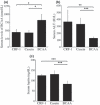Dietary supplementation with branched-chain amino acids suppresses diethylnitrosamine-induced liver tumorigenesis in obese and diabetic C57BL/KsJ-db/db mice
- PMID: 19906067
- PMCID: PMC11159020
- DOI: 10.1111/j.1349-7006.2009.01402.x
Dietary supplementation with branched-chain amino acids suppresses diethylnitrosamine-induced liver tumorigenesis in obese and diabetic C57BL/KsJ-db/db mice
Abstract
Obesity and related metabolic abnormalities, including insulin resistance, are risk factors for hepatocellular carcinoma in non-alcoholic steatohepatitis as well as in chronic viral hepatitis. Branched-chain amino acids (BCAA), which improve insulin resistance, inhibited obesity-related colon carcinogenesis in a rodent model, and also reduced the incidence of hepatocellular carcinoma in obese patients with liver cirrhosis. In the present study, we determined the effects of BCAA on the development of diethylnitrosamine (DEN)-induced liver tumorigenesis in obese C57BL/KsJ-db/db (db/db) mice with diabetes mellitus. Male db/db mice were given tap water containing 40 ppm DEN for an initial 2 weeks and thereafter they received a basal diet containing 3.0% of BCAA or casein, which served as a nitrogen content-matched control of BCAA, throughout the experiment. Supplementation with BCAA significantly reduced the total number of foci of cellular alteration, a premalignant lesion of the liver, and the expression of insulin-like growth factor (IGF)-1, IGF-2, and IGF-1 receptor in the liver when compared to the casein supplementation. BCAA supplementation for 34 weeks also significantly inhibited both the development of hepatocellular neoplasms and the proliferation of hepatocytes in comparison to the basal diet or casein-fed groups. Supplementation with BCAA improved liver steatosis and fibrosis and inhibited the expression of alpha-smooth muscle actin in the DEN-treated db/db mice. The serum levels of glucose and leptin decreased by dietary BCAA, whereas the value of the quantitative insulin sensitivity check index increased by this agent, indicating the improvement of insulin resistance and hyperleptinemia. In conclusion, oral BCAA supplementation improves insulin resistance and prevents the development of liver tumorigenesis in obese and diabetic mice.
Figures








Similar articles
-
Preventive effects of branched-chain amino acid supplementation on the spontaneous development of hepatic preneoplastic lesions in C57BL/KsJ-db/db obese mice.Carcinogenesis. 2012 Dec;33(12):2499-506. doi: 10.1093/carcin/bgs303. Epub 2012 Oct 1. Carcinogenesis. 2012. PMID: 23027617
-
Supplementation with branched-chain amino acids inhibits azoxymethane-induced colonic preneoplastic lesions in male C57BL/KsJ-db/db mice.Clin Cancer Res. 2009 May 1;15(9):3068-75. doi: 10.1158/1078-0432.CCR-08-2093. Epub 2009 Apr 14. Clin Cancer Res. 2009. PMID: 19366832
-
Acyclic retinoid inhibits diethylnitrosamine-induced liver tumorigenesis in obese and diabetic C57BLKS/J- +(db)/+Lepr(db) mice.Cancer Prev Res (Phila). 2011 Jan;4(1):128-36. doi: 10.1158/1940-6207.CAPR-10-0163. Epub 2010 Nov 11. Cancer Prev Res (Phila). 2011. PMID: 21071580
-
Nutraceutical approach for preventing obesity-related colorectal and liver carcinogenesis.Int J Mol Sci. 2012;13(1):579-595. doi: 10.3390/ijms13010579. Epub 2012 Jan 5. Int J Mol Sci. 2012. PMID: 22312273 Free PMC article. Review.
-
Insulin action, type 2 diabetes, and branched-chain amino acids: A two-way street.Mol Metab. 2021 Oct;52:101261. doi: 10.1016/j.molmet.2021.101261. Epub 2021 May 24. Mol Metab. 2021. PMID: 34044180 Free PMC article. Review.
Cited by
-
Chemoprevention of obesity-related liver carcinogenesis by using pharmaceutical and nutraceutical agents.World J Gastroenterol. 2016 Jan 7;22(1):394-406. doi: 10.3748/wjg.v22.i1.394. World J Gastroenterol. 2016. PMID: 26755885 Free PMC article. Review.
-
Plasma-free amino acid profiles are predictors of cancer and diabetes development.Nutr Diabetes. 2017 Mar 13;7(3):e249. doi: 10.1038/nutd.2016.55. Nutr Diabetes. 2017. PMID: 28287627 Free PMC article. Review.
-
Nutritional composition of Eragrostis teff and its association with the observed antimutagenic effects.RSC Adv. 2019 Jan 28;9(7):3764-3776. doi: 10.1039/c8ra09733j. eCollection 2019 Jan 25. RSC Adv. 2019. PMID: 35518081 Free PMC article.
-
Long-term Branched Chain Amino Acid Supplementation Ameliorates Diethylnitrosamine-induced Liver Glutathione S-transferase-p Positivity in Zucker Fatty Rats.J Clin Exp Hepatol. 2013 Sep;3(3):192-7. doi: 10.1016/j.jceh.2013.08.008. Epub 2013 Sep 6. J Clin Exp Hepatol. 2013. PMID: 25755500 Free PMC article.
-
A novel diet-induced murine model of steatohepatitis with fibrosis for screening and evaluation of drug candidates for nonalcoholic steatohepatitis.Physiol Rep. 2016 Nov;4(21):e13016. doi: 10.14814/phy2.13016. Physiol Rep. 2016. PMID: 27821715 Free PMC article.
References
-
- El‐Serag HB, Rudolph KL. Hepatocellular carcinoma: epidemiology and molecular carcinogenesis. Gastroenterology 2007; 132: 2557–76. - PubMed
-
- Calle EE, Rodriguez C, Walker‐Thurmond K, Thun MJ. Overweight, obesity, and mortality from cancer in a prospectively studied cohort of U.S. adults. N Engl J Med 2003; 348: 1625–38. - PubMed
-
- El‐Serag HB, Hampel H, Javadi F. The association between diabetes and hepatocellular carcinoma: a systematic review of epidemiologic evidence. Clin Gastroenterol Hepatol 2006; 4: 369–80. - PubMed
-
- El‐Serag HB, Tran T, Everhart JE. Diabetes increases the risk of chronic liver disease and hepatocellular carcinoma. Gastroenterology 2004; 126: 460–8. - PubMed
-
- Marra F, Gastaldelli A, Svegliati Baroni G, Tell G, Tiribelli C. Molecular basis and mechanisms of progression of non‐alcoholic steatohepatitis. Trends Mol Med 2008; 14: 72–81. - PubMed
Publication types
MeSH terms
Substances
LinkOut - more resources
Full Text Sources
Other Literature Sources
Medical
Miscellaneous

